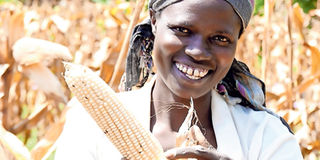One more reason to grow soya bean

Mary Kageya displays a maize cob in her farm in Busia. Prof Mathew Dida, a lecturer at Maseno University’s Department of Agriculture says soya beans produce some repelling chemical that induces suicidal germination of the striga weed. PHOTO | LEOPOLD OBI | NMG
What you need to know:
- Soya bean, an edible and a highly nutritious legume, is planted 30 inches apart and matures three months after planting.
- The crop is not only a good source of protein, but it fixes nitrogen in the soil and now, farmers like Kageya are using it to fight striga.
- Prof Mathew Dida, a lecturer at Maseno University’s Department of Agriculture, who has been researching on the striga weed for the last 16 years, says soya beans, just like most legumes, produce some repelling chemical that induces suicidal germination of the striga weed.
- The weed is prevalent in western Kenya due to a number of factors, among them floods which hasten the spread.
Mary Kageya, 38, beams with joy as she winnows heaps of soya beans she just threshed.
A smallholder farmer in Mkemo village, Busia County, Kageya began growing the beans some six years ago, intercropping them with maize with much success.
She harvested some 20kg of the legume in her first harvest. But in the process, she also discovered that the crop could smoother the invasive striga weed on her farm.
Bouyed by the realisation, she planted the legume on an acre, intercropping it with maize or rotating it with maize to suppress the parasitic weed that usually kills the cereal crop. Her harvest improved.
But there was a challenge selling the produce due to undefined market.
“Traders at the nearby Busia market used to buy a kilo at Sh70, but they would mostly take on credit and pay in portions or sometimes not pay at all,” explains the mother of six, who later found help after Civic Engagement Alliance Kenya programme, a Dutch government supported initiative, linked them to bulk buyers of the legume.
This season, the farmer harvested some 10 90kg bags of soya from the farm, and sold them at a cereal aggregation chain known as One World Action.
Soya bean, an edible and a highly nutritious legume, is planted 30 inches apart and matures three months after planting.
The crop is not only a good source of protein, but it fixes nitrogen in the soil and now, farmers like Kageya are using it to fight striga.
“This season I intercropped the entire maize farm with soya beans and the results were excellent.”
For the farmer, growing the legume has proved a quite profitable venture compared to the farming of the regular beans
Since farmers in parts of western Kenya grow their crops in two seasons a year, Kageya intercrops the beans and maize in the first season then grows the beans alone in the second.
But she not only grows the legume for the market.
SUPRESS THE WEED
“I cook the beans too. Sometimes I blend them with sorghum for making porridge for my children.”
John Kwoba, One World Action Busia regional director, says they work with over 2,000 soya bean farmers in the area.
The organisation buys the beans from farmers before reselling to other food blending companies in Busia, Kakamega and Nairobi.
They buy a kilo of the beans at a minimum Sh50 wholesale price and the farmers are paid promptly.
Kwoba further states that they have mobilised the buyers to enhance market for the beans.
“We are collaborating with stakeholders like Kenya Agricultural and Livestock Research Organisation (Kalro) to provide quality seeds to farmers,” says Kwoba, adding they also provide extension services.
The organisation advocates for 1 per cent foreign materials in dried beans and 12 per cent moisture content.
There are always broken seeds during threshing but the buyer says there is no wastage in soya since the seeds can be used in processing animal feeds.
Prof Mathew Dida, a lecturer at Maseno University’s Department of Agriculture, who has been researching on the striga weed for the last 16 years, says soya beans, just like most legumes, produce some repelling chemical that induces suicidal germination of the striga weed.
“The weed can sprout but it cannot attach itself to the legume’s roots and it is killed by the chemicals,” explains Prof Dida.
“Other crops such as cotton, groundnuts and cow peas can also be planted to supress the weed.”
He said that in normal circumstances, striga weed would germinate and attach itself to the plant’s roots. It then sucks all the nutrients and minerals the plant needs for growth, then poisons it making it stunted.
Farmers can lose up to 90 per cent to 100 per cent of their yields under striga weed attack making it a threat to food security.
The weed is prevalent in western Kenya due to a number of factors, among them floods which hasten the spread.





